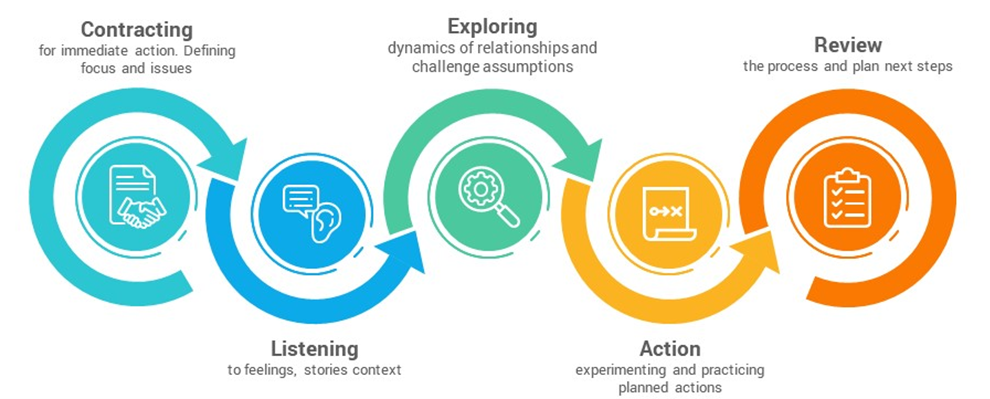
Management in a complex, changing world
Why Resolving Conflict Matters
Since conflicts inevitably arise whenever two or more people work together, managers need to master the art of conflict resolution. This blog covers key points that managers should know about conflict, including what causes it and strategies to resolve conflicts successfully.
Understand the Nature of Conflict
Conflict is a natural by-product whenever people come together for a common purpose, whether for business, public policy or socializing. It arises when differences in opinions, values, needs or personal interests collide. We tend to see conflict as undesirable, but differences of opinion are the breeding ground for progress and innovation when dealt with in the correct way. Conflict turns negative when it remains unresolved and devolves into a win-lose mentality where any concession to the other side is unacceptable. This leads to a deadlock: each side thinks that in order to get what they want the other side cannot possibly get anything that they want. If left unresolved, such unhealthy conflict destroys good will and provokes resentment, anger, blame and retaliation.
By understanding the sources of conflict and proven ways to resolve it, managers can overcome differences and forge a united approach to the issues that organizations face in these challenging times. To begin, managers need to recognize the different types of conflicts that arise in the workplace. These various types of conflicts can be categorized as: interpersonal, intrapersonal, intergroup and intragroup. Each is described below.
|
Conflict Between |
Conflict Within |
|
Individuals (Interpersonal) |
One individual (Intrapersonal) |
| Groups (Intergroup) |
One group (Intragroup) |
Table One: Sources of Conflict
Interpersonal Conflict
This occurs when two or more individuals have different opinions, personalities, values or goals that lead them into opposition. Such conflict may include disagreements between colleagues over work tasks or competition for desirable work and promotions. It can also be based on a clash of personalities such as extroverts being too loud and expressive for introverts’ taste while the latter are too silent and seemingly unengaged from the extroverts’ viewpoint. While personal differences should always be respected in the name of diversity and inclusion, chronic interpersonal conflict leads to tension and decreased collaboration, harming team dynamics and work productivity.
Intrapersonal Conflict
Intrapersonal conflict takes place within an individual, involving internal struggles or dilemmas about goals, values, roles or decisions. We all feel this as a natural part of life. Whenever we are given a choice, we must resolve internal conflicts regarding the benefits and risks of the choices we make. One common example is work-life balance. Working adults with children feel torn between career aspirations and family commitments, often experiencing stress when the two collide. If left unresolved, intrapersonal conflict leads to stressful anxiety and decreased job satisfaction and performance.
Intragroup and Intergroup Conflicts
Conflicts between or among work groups within an organization are another frequent source of tension that can create serious obstacles. Intragroup is the type of conflict that occurs within a single group or work team, often closely related to interpersonal conflicts. For example, teams commonly confront differences in opinions about how to complete a project, conflicts over roles and responsibilities, or disagreements about work plans and schedules. When these conflicts go unresolved, they disrupt team cohesion, reduce morale, and impact the team’s ability to achieve its goals. Intergroup conflicts arise between different work groups or departments. These often involve competition over scarce resources or competing priorities. Left unresolved, they lead to reduced cooperation and organizational silos that hinder achievement of strategic goals.
By understanding these different types of conflict, managers can better identify the root cause and devise appropriate strategies to maintain a productive and harmonious work environment.
Identify the Root Cause
When conflict arises, it is tempting to focus on its symptoms like hurt feelings and project gridlock. However, managers should go beyond the surface issues to identify the underlying causes of the conflict. To do this, managers need to encourage open and honest communication, ensuring all parties have a chance to express their viewpoints. Managers should use active listening techniques such as probing questions and checks for understanding. Pay attention to both what is being said and how it is being expressed. Show empathy and verify your understanding of the root cause.
Use Collaborative Problem-Solving
Once the nature and root cause of the conflict are determined, the next step is to involve all stakeholders in brainstorming possible solutions. No idea should be rejected out of hand, since the most outlandish is often the best solution in the end. Once a list of viable solutions emerges, stakeholders should evaluate their options, discussing the pros and cons of each solution and seek a mutually acceptable resolution. The best solutions are win-win, where all parties feel their concerns have been addressed and can live with the outcome. This might represent a compromise or an entirely new way of addressing the underlying issues.
Implement Solutions
After settling on a solution, ensure all parties understand the details and their respective roles in implementing it. Conflict resolution should be treated like any other project assigned to a manager. Create a plan that includes objectives, work breakdown structure and timelines. Hold people accountable for completing their parts and reward those who embrace the solution and the changes it brings.
Prevent Conflict
In an ideal world, conflicts should be anticipated and resolved before they become serious impediments to progress. Proactive conflict resolution can include any of the following:
Promote a Positive Work Environment
Fostering a collaborative environment that values teamwork and cooperation is the best proactive step organizations can take to create a positive work environment that minimizes unhealthy conflict. Managers should encourage team-building activities and exercises to strengthen relationships and reduce the likelihood of conflicts. Social events can strengthen bonds among employees. Achievement of key work objectives gives the entire team something to be proud of and emphasizes the collaborative nature of work. When conflict arises, use feedback mechanisms to improve future conflict resolution processes.
Set Clear Policies and Procedures
Leaders should establish clear guidelines and protocols for conflict resolution within their organization. This could include a standard process for root cause analysis, such as independent fact finding and opportunities for all affected parties to be heard. It should also clearly spell out behaviors that are unacceptable, such as threatening or retaliating against others. Disseminate policies widely so that all employees understand the steps to take when a conflict arises and the behaviors that are off limits.
Provide Training and Development
One of the most effective proactive steps is to offer training programs on conflict resolution, communication and interpersonal skills, and emotional intelligence. These trainings equip employees and managers with the tools they need to handle conflicts effectively and avoid the negative consequences of unresolved conflicts.
Know When to Seek Help
Some conflicts are so deep-rooted, they require expert advice and extra effort to resolve. Managers need to recognize when a conflict is beyond their ability to fix so that they seek assistance from HR or a professional mediator. Don’t hesitate to involve upper management if necessary, especially if a conflict is likely to result in legal action or spill over into public perceptions of the organization.
By understanding and implementing these principles, managers can effectively handle conflicts and create a more harmonious and productive work environment where everyone’s contributions are recognized and rewarded.


